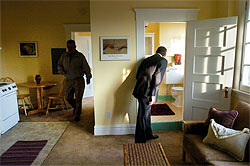|
|
|
 Civic leaders tour
one of the apartments in the remodeled Stockton Hotel. The
mission revival-style hotel - which had no parking - went into
decline with the advent of the auto. It was boarded up for
more than a decade until financial incentives helped lure a
developer.
Civic leaders tour
one of the apartments in the remodeled Stockton Hotel. The
mission revival-style hotel - which had no parking - went into
decline with the advent of the auto. It was boarded up for
more than a decade until financial incentives helped lure a
developer.
• See
additional images
Sacramento Bee/Randall Benton
| |
|
A landmark reclaimed
Stockton Hotel to reopen after $28 million makeover
By Cheryl Miller -- Bee Correspondent
Published 2:15 am PST
Sunday, December 19, 2004
STOCKTON - The Hotel Stockton, a
once-posh Central Valley inn that deteriorated over the years into a
vacant, block-long eyesore, reopens next month with a fresh look and a new
mission of housing the city's poor and elderly.
Sacramento developer Cyrus Youssefi last week offered dignitaries an
early look at the results of the building's $28 million makeover.
"If 2 1/2 years ago you had told me this was going to be the scope
of the work, I don't know what I would have done," Youssefi said as he
stood in the refurbished two-story lobby. "But I like challenges."
Youssefi and project architect Mike Malinowski are the same team that is
rehabilitating the historic Globe Mills complex in Sacramento's Alkali
Flat.
The Hotel Stockton is a cornerstone of Stockton's plans to spruce up a
downtown landscape historically noted for single-occupancy hotels, vacant
buildings and sidewalks that stand empty after 5 p.m.
"This is something that for 100 years, people knew they were in
Stockton when they saw the distinctive Hotel Stockton," said Steve
Pinkerton, the city's housing and redevelopment director. "Now with the
housing upstairs, we'll have people downtown 24 hours a day, and with the
retail and restaurant on the first floor, we'll be expanding the
entertainment district."
Listed on the National Register of Historic Places, the Hotel Stockton
was built in 1910 after local merchants raised $500,000 for its
construction. Store owners feared that, without a large-scale hotel,
tourists and businessmen would bypass Stockton for more accommodating
Central Valley cities.
When the mission revival-style hotel opened, guests arriving on trains
and Delta steamers could rent one of 200 private-bath guest rooms for $2 a
night. A third-floor terrace allowed the well-heeled and high school
prom-goers to spend warm summer nights mingling around a stately fountain
while the sun set over Mount Diablo. The fifth floor included a suite of
showrooms where traveling salesmen could display their goods.
Americans' passion for cars proved the hotel's death knell. The
high-rise had no parking lot, and potential guests turned increasingly to
freeway-accessible motels and lodges. Ownership changed hands several
times. San Joaquin County housed its welfare offices there until 1992, but
various renovation plans failed over the years. The building stood empty
and boarded-up for more than a decade.
In March 2002, Stockton officials and Youssefi's development group
struck a deal to convert the hotel into apartments and retail space with a
financing package that includes $15 million in affordable housing tax
credits and city subsidies of more than $7 million.
The hotel's historic designation forced designers to retain the
building's architectural style while upgrading the structure to meet
modern-day safety codes.
Crews removed 100,000 tiles from the leaky roof, re-formed them,
hammered out any dents, stripped them of paint, refurbished them and
replaced them over a one-of-a-kind waterproof membrane project architect
Malinowski created.
Construction workers also removed, refinished and reinstalled all 745
windows to meet historic specifications. And 60 parking spaces have been
added to what was once the basement.
Malinowski called the project "bigger, tougher, meaner and badder" than
he originally envisioned. "But it's also more exhilarating."
The hotel's ground floor has been set aside for shops and a restaurant.
Sacramento eatery Paragary's has already signed a letter of intent with
the retail managers, although any lease deal would likely include a
significant subsidy from the city.
Paragary's or another restaurateur will operate banquet facilities on
the restored third-floor terrace, redevelopment director Pinkerton said.
The nearly finished project includes 96 studios and 60 one-bedroom
apartments. Rent will run roughly half of Stockton's market rate, and
qualified tenants can earn no more than 45 percent of the area's median
income. Youssefi said he has already compiled a waiting list of 205
potential residents.
The man likely to be the first tenant is already familiar with the
layout, Youssefi said. He was once a bellboy for the Hotel Stockton.